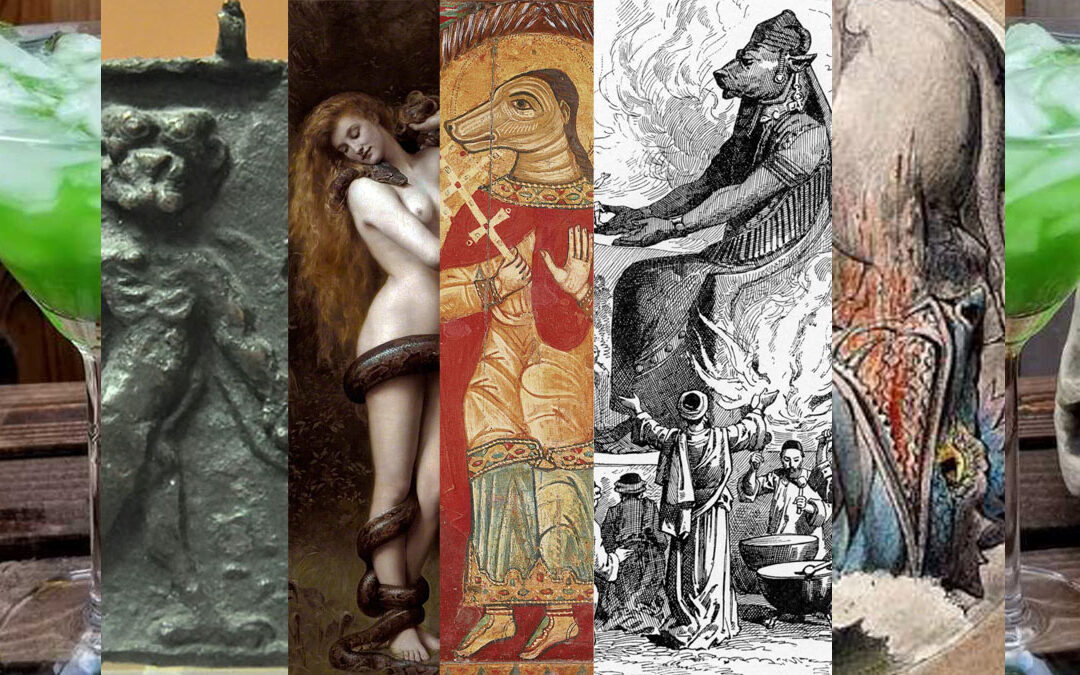
This week’s free-wheeling chat starts and kind of ends with Mesopotamian demonology, but it’s our first talk about demons so we veer all over the millennia. Join us. Bonus points if you can find the narrative thread.
As so many discussions about demonology begin, Jamin and Jacob spend way too much time talking about the cleanliness of their kitchen, which is large, weirdly shaped, and has a little vestibule beside the fridge and under the spices, out of sight and out of mind, where we reliably send produce to die.
The hosts don’t think this week’s recipe tastes like demon possession. It actually sounds kind of nice. What should demon possession taste like? Copper and gently blackened sulfur? This one tastes like rum and oranges.
If you have “Satan” as one of your Google News keywords, you probably got a lot of stories about a Boston man who claimed to be Subway Satan, possibly to get a date with a passenger. This may work on a rom-com, but on a spectrum of “Hot or Not?” the hosts have decided that this will be defining “not.” But we do generally agree that both the Pope Lick Monster and Tom Ellis as Lucifer are exponentially hotter than a man with a hoodie and an “I am Satan” lockscreen.
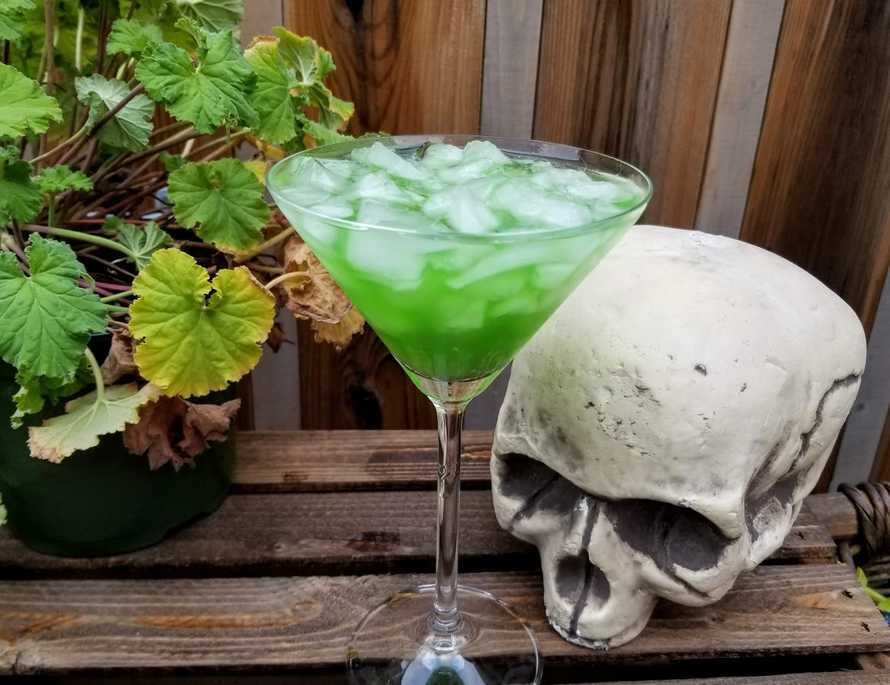
Photo by Fizzybrat!
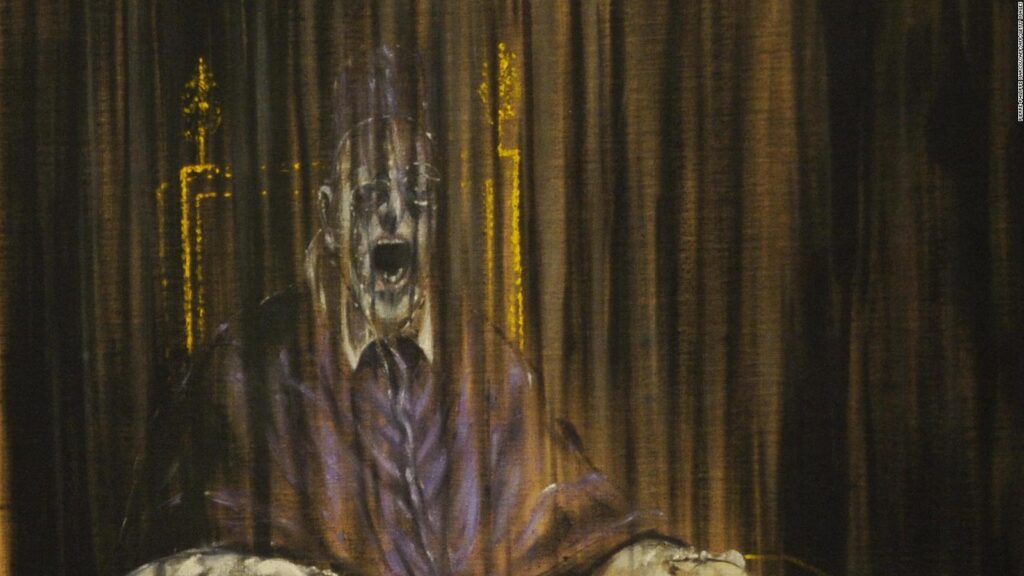
Worth noting, Francis Bacon, who painted monstrous screaming pope images, is NOT the Francis Bacon (1561-1626) who probably wrote Shakespeare’s plays. This caused Jacob some confusion.
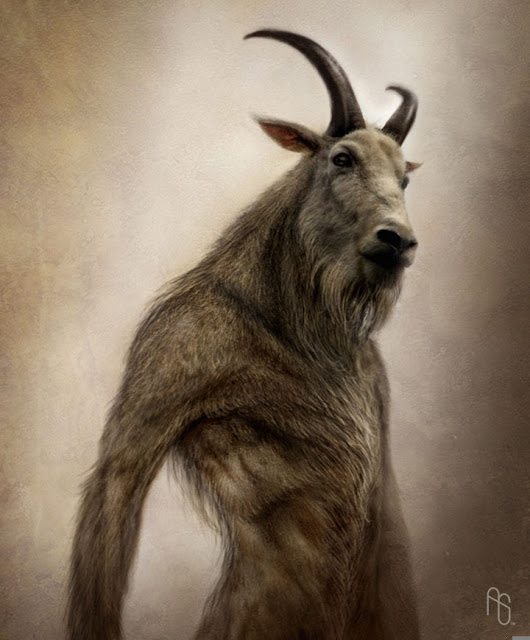

The Pope Lick Monster and Tom Ellis as Lucifer, who are both hotter than a guy in a hoodie texting you with claims of autosatanism.
Zozo
Who is Zozo, we hear you asking? He’s the demon of the Ouiji board, perhaps caused by nervous jittering and twitchy muscles during an Ouiji session. A bit of an urban legend. Of little or no relation to Led Zeppelin’s “Four Symbols,” the feather of Ma’at, Jimmy Page’s enigmatic “Zoso” (which according to Jimmy meant “I eat bananas,” but that wasn’t one of his lucid moments). Then there’s a few general purpose Rosicrucian trifoils, for variety.
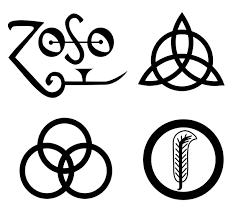
Rabisu
Unfortunately, there’s no canonical imagery on the Rabisu. And they’re not QUITE bureaucracy demons. They’re lurkers outside doors, things in the darkness that drag people away, and attack souls who are travelling to the city of the dead. The word comes from “to crouch, to lie in wait, or basically, “one who lies in wait.” It’s both the name of a demon and a government position, kind of like bailiff (Dictionary of Deities and Demons of the Bible), and the two meanings kind of flow into each other, ultimately.
St Christopher Cynocephalus
True story: St. Christopher is 16 feet tall and has a dog’s head. He is many great things, but “real” is maybe not one of them.
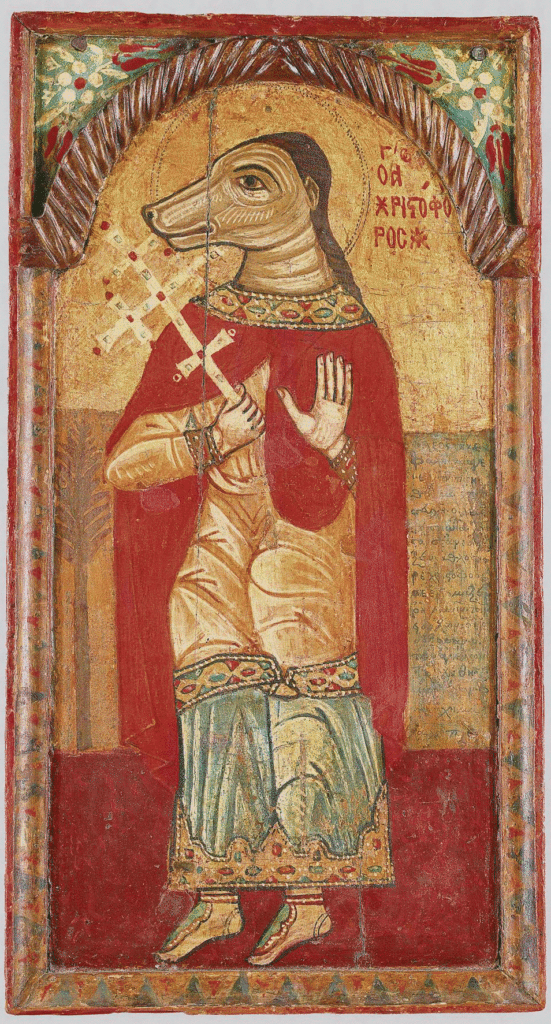
It’s likely that there were rumors of far-away tribes of dog-headed people (see “cynocephali“) and having Christopher be a part of this far-away tribe added some exotic charm to his legend. Wiki also mentions that perhaps there was a mistranslation of “Canaanite” as “canine.” A lovely blog post here about Christopher’s dog-headed, gigantic myth.
Pazuzu
We come and go a lot on Pazuzu, let’s try to get him all in one place here.
He had a very powerful family: His father was the god Hanbi, about which we know bugger all but he was apparently a powerful god of evil. His brother was Humbaba, who was, in the spirit of Cerberus, the guardian of the forest wherein the gods lived. He was huge and had seven powerful auras of terror and Gilgamesh killed him for no good reason–Humbaba, that is.
He’s definitely a demon, with a lion face, eagle-like talons, wings (interestingly wings that go both up AND down, is that some mixture of heaven and hell elements? Usually underworld wings go down and heaven wings go up…) and of course a snake penis, which is noteworthy because some of the hosts are five year olds.
He’s the prince of the demons of the air. He’s also used to drive away other evil spirits, particularly ones that interfere with motherhood and childbirth. He’s got a lively 20th-21st century presence. The Exorcist really kept him alive, and he makes appearances in The Simpsons, Constantine, and any number of et ceteras. In Dungeons and Dragons he’s one of the oldest demons in the game, and exceedingly friendly and helpful, which is never a good thing.
The World History Encyclopedia touches on Jeremy Black’s stages of Pazuzu/demonic evolution.
There’s a fan theory about whether or not Pazuzu actually possessed Regan in The Exorcist. In the movie, it’s pretty clear that Captain Howdy, Pazuzu, and the possessing demon are the same character. The book is a little less clear, since it doesn’t name the demon directly. The theory hinges on the idea that Pazuzu tends to be protective of girls and is invoked to protect them, but Lamashtu is more of a child-killer, and more likely to speak in a female voice. Since the author of the book assumed Regan was possessed by Pazuzu it’s not a very strong argument, but so far as fan theories go, it’s a good one.
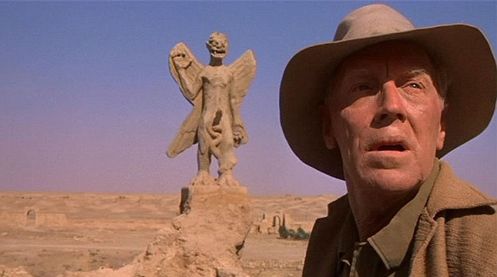
Max Von Sydow costarring with Pazuzu. DON’T LOOK LEFT, MAX
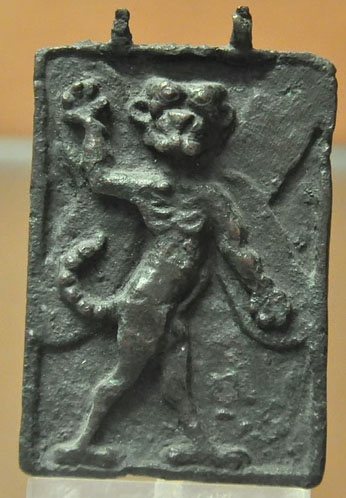
Ba’al
there are an awful lot of Baals out there. For a couple of reasons. First, it was a catch-all word for king/owner/master/husband (pretty similar to “Lord.”) So a number of local gods, categorically, the Baalim, took on that name. So Baal-Berith, Baal-Hermon, several others, and then the feminine form Baalat as well. So first a lot of little gods partook of Baal-ness, and then over the years the relationship flipped, and the little baals became his servants, or aspects of Baal Prime.
This late-stage transformation of Baal into a single chief god created a lot of weird paternity issues.
Anyway, Baal becomes extremely active in the 1500-1000-ish as a big rival of YHVH and the bugaboo of the Jewish faith. In the Old Testament, there was a conclusive show-down between the prophet Elijah wherein Yahweh was, in the book written by Yahweh’s people, the overwhelming victor, but he stuck around for quite some time, possibly being subsumed into the Roman pantheon as Saturn or Jupiter Belus.
As a demon with a very long pedigree, Bael, Beelzebub, and Belphegor all carry his name as demon princes of wrath, gluttony, and sloth, and a number of other demons draw their names from the list of Baalat. Astaroth may be an incarnation of him as well. He was a rival god that gave El/JHVH a run for his money and a major name in the bible, and logically, is a frequent member of Hell’s hierarchies.
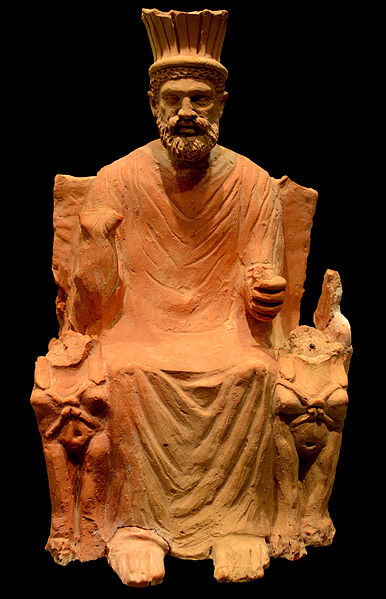
Baal-Hammon on throne, AlexanderVanLoon
Unruly Mystical Beasts
The two big names in this catalog, which turn up later in demonologies sometimes as members of the Big Seven princes of hell, are Leviathan (occasionally Prince of Envy or Wrath) and Behemoth (occasionally Demon of Gluttony.) Both are primeval chaos monsters dating from creation. According to Jewish lore both of these would become food for the righteous, so them’s apparently good eating. There’s a third, the Ziz, who is possibly some kind of bird, griffin, or dragon, sometimes related to the legend of the phoenix.
It’s probably safe to add to this list Tiamat, who likely figures into Leviathan’s ancestry, and is also a female aquatic chaos beastie. Sadly, these majestic creatures are highly endangered, pushed to the edge of extinction by sky gods and Greek heroes, who prove their legitimacy by means of the “combat myth” motif – forces of order conquering the chaotic forces of nature to establish, say, a new pantheon.
In the Baal cycle, Baal and Anat kill Mot, a powerful demon who may or may not have been El’s son, conquering death to establish Baal’s legitimacy as “He’s All That.” Since Mot is sometimes a giant sluglike monster instead of a standard god, this likely puts him into the category of “unruly mystical beasts” as well. Because Baal dies and gets back up, comparisons have been made between him and Jesus. However, in the same legend, Mot dies and gets back up, but for some reason this doesn’t evoke as many comparisons to Jesus. Life’s not fair if you’re a giant tusked slug demon.
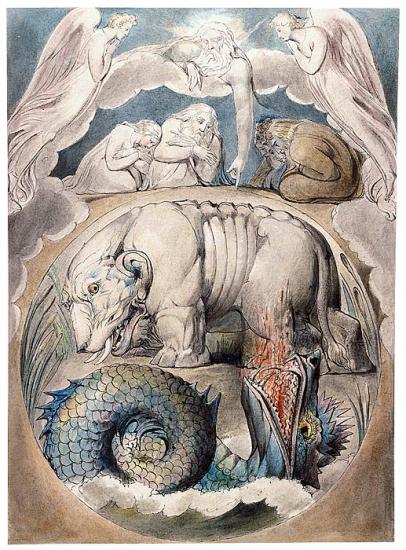
William Blake, Behemoth and Leviathan
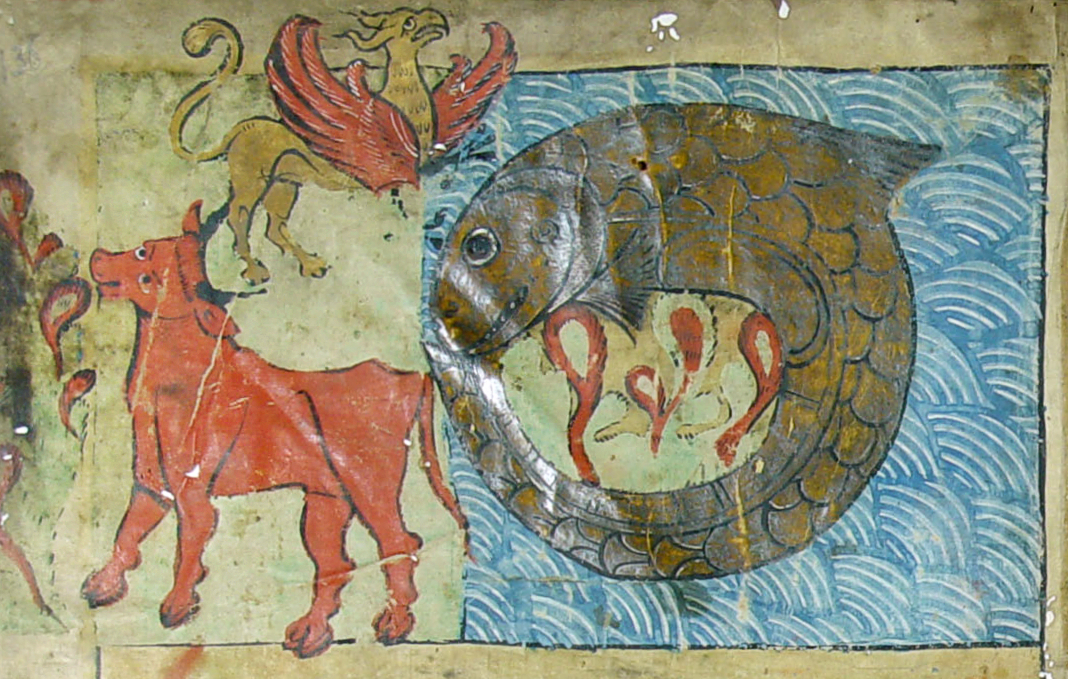
Leviathan, Behomth, and Ziz
Where the Wild Things Are…
It’s unfortunately brief, we don’t spend a lot of time on what’s a really neat piece of old testament: Isaiah 13:20 and 34:14.
If you look at a bunch of these translations side by side, it’s obvious that there’s something weird going on, it’s not just a list of animals. “Wild goats will dance” gets translated as “satyrs will dance,” “the hairy ones will dance,” “devils will dance,” “goat-demons will dance there.” Enigmatically one translation also says “and their houses shall be full of ferrets,” which is kind of cute. Jackals, hyenas, “howlers,” and “doleful creatures” fill the houses. Because this is poetic language, and it picks up parallels with the second Isaiah passage 34:14, there’s a strong suggestion that these are wilderness demons as much as desert animals…although again a lot of that involves looking at how the original language creates parallels in the way these are listed. The jackals are meeting with the seirim (satyrs, goat demons…we mentioned them earlier in our discussion of Azazel, king of hairy goat demons. Overall there’s a sense that there’s an uncanny and spooky assembly dancing in the ruins of Babylon, and the jackals, “howlers,” hyenas, and possibly ferrets and ostriches are meeting with satyrs and Lilitu demons (or maybe Lilith herself) in a sort of dark sabbat.
Lilith
We did NOT give Lilith the time she deserved, I’m sure she’ll be coming back at some point in time. She’s a major character and deserves more than five minutes.
Adam’s second wife is mentioned in the Midrash. Her story’s pretty painful…god (infallible god?) made a tactical error and let Adam see her being constructed, and it freaked the little guy out. She may have been destroyed without ever having a name. Or not. Maybe she has a happy ending.
Lilith was also created in the image of god, as much as Adam was, and that didn’t really work out well. She wanted something like equaility, and God/Adam weren’t ready for that. Although I like the idea that she slept with the archangel Samael and that spoiled her for humans forever.
In modern times, she’s had a lot of positive press as a heroic figure, a mythic feminist icon. And there’s truth that’s come to be there over the years, but originally she was a demonic, child-snatching bogey monster, more on the order of a night-hag or a vampire than a suffragette. Wiki has a lot of different versions of her legends.
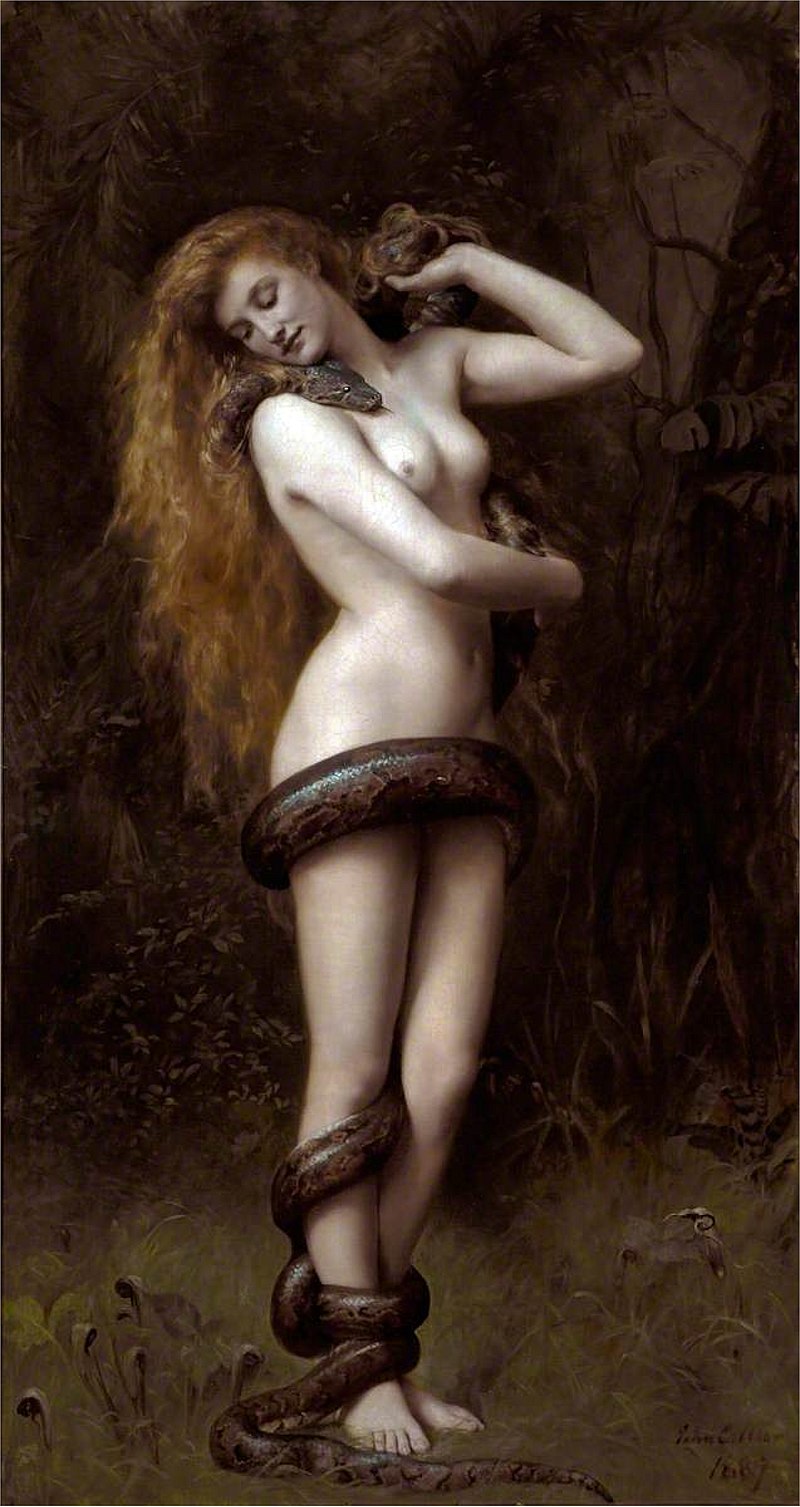
Lilith by John Collier
Jacob particularly likes Lilith in her incarnation in Steve Jackson Games’ “In Nomine” role-playing game, a modern fantasy game of angels and demons faffing around and disrupting each other’s plans some time before the end of the world. The game has a good sense of humor (although the French original was apparently even more tongue-in-cheek). It’s got a lot of interesting ideas…magic is interpreted with musical metaphors that play well; the game has sliders for humorous/conspiratorial/gritty, and it’s just a lot of fun to read.
This game’s take on Lilith is that she’s become one of the demonic princes of Hell, although she’s still technically human. Her goal is to stay out of the politics and life a free life, although that’s extremely challenging when Lucifer is involved as a background character. So instead she trades favors with the best of them.
Steve Jackson Games is an Austin company, which is kind of neat. Perhaps because of this the In Nomine setting book “Night Music” was the first RPG to ever detail Austin as a setting.
Tonantzin? Broadly this is an Aztec honorific, usually given to goddesses, sometimes to women and sometimes as a given name. Broadly it means “Honored Mother,” and isn’t any one single goddess…so it’s not an unreasonable title for the syncretic Lady of Guadalupe, who may or may not have been a merger of the Virgin Mary and a pre-columnbian Tonantzin, “Coaltlaxopeuh.” No relation to Lilith,although they both seem to have an on-again-off-again relationship with serpents.
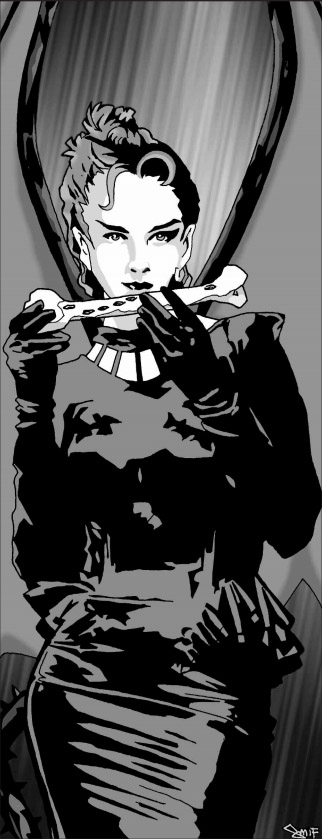
Gallu
The Gallu…these are real underworld terrors, serving as something like the police of the underworld. They’re the origins of the word “ghoul.” There may be only seven of them, and they may serve as seven powerful demons in the Mesopotamian underworld, or possibly they’re the seven gods of the underworld. Everything comes in sevens, that number isn’t particularly meaningful in the final analysis.
I don’t entirely know why they specifically “crush no bitter garlic,” although it may fall into the general category of “humans like garlic, and these demons are monstrous, so they don’t.” Victoria suggests that allum plants (onions, garlic, etc.) can increase lactation, and that may be a reason the Gallu don’t particularly like garlic. It stands out as an odd line though. I wonder if there’s some connection between the word “allum” and “alu,” another name for these demons…that’s probably a stretch.
Anyway: noteworthy features: They can’t be bribed, they can’t be stopped, they’re generally heartless, and tend to interrupt people having sex.
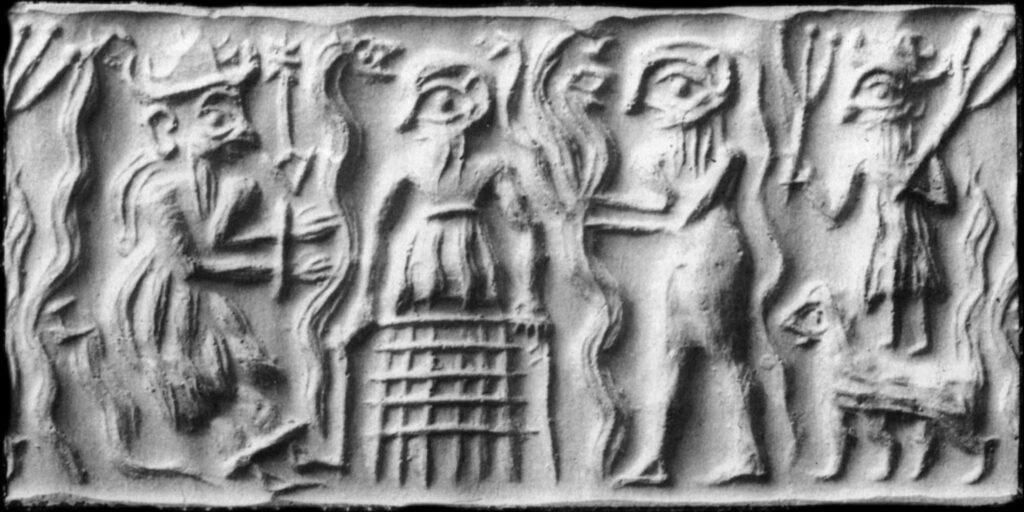
Moloch
The myth behind the myth…the common belief is that Moloch is an ancient god that really enjoyed child sacrifice, and took the form of a bull idol. However, this is under debate…any reference to Moloch as a stand-alone entity is from the Bible, and isn’t supported by evidence from outside that specific Judeo-Christian worldview. Maybe Moloch is just a word referring to sacrifice generally, and the “mlk” sacrifice was also offered to Baal, and even Yahweh.
The story of Moloch that seems to have the longest shelf-life: the reason the valley of Gehenna was considered unclean was that it was the site of this kind of sacrifice.
This hasn’t been resolved either way. Other scholars suggest that he had his own temple, or perhaps that he was an aspect of Nergal. Regardless, he was adopted into the demonologies and made a splash in the middle ages…there’s a lot of drama in his story…so he exists as much as anything else in your typical creepy codex.
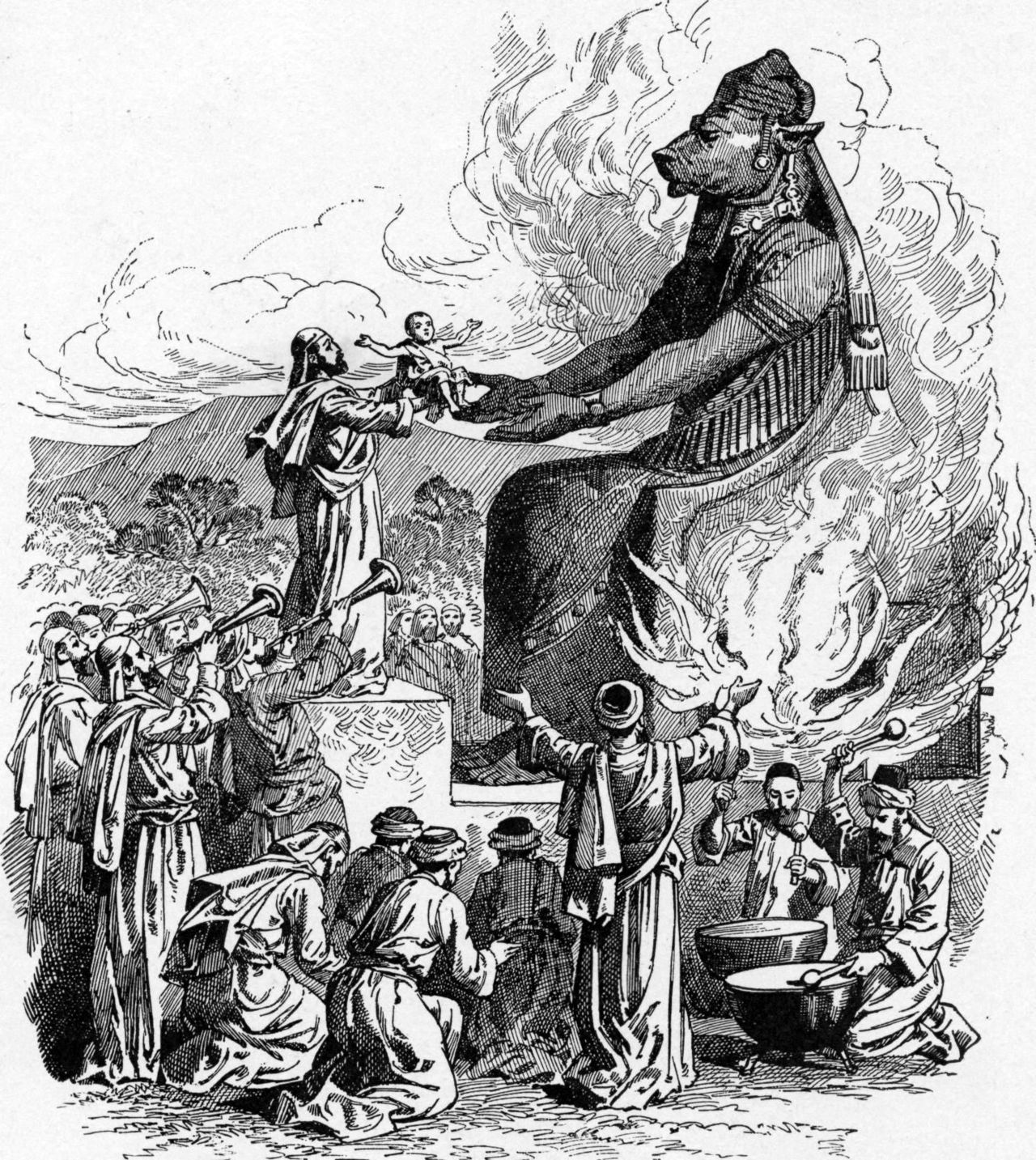
What you wanted to know about Genesis 38:8 (but were afraid to ask)
8 Then Judah said to Onan, “Sleep with your brother’s wife and fulfill your duty to her as a brother-in-law to raise up offspring for your brother.” 9 But Onan knew that the child would not be his; so whenever he slept with his brother’s wife, he spilled his semen on the ground to keep from providing offspring for his brother. 10 What he did was wicked in the Lord’s sight; so the Lord put him to death also. (New International Version)
The Straight Dope, which should be everyone’s first choice for old testament exegesis, has a fair bit of stuff to say about the sin of Onan, and it’s not weighted down with too much of a religious agenda. There’s a few possibilities for what the Sin of Onan might be, and no telling how much this weird little passage has informed the discussion of contraception and masturbation over the millennia. But there’s also a lot of marriage law, heirship/property inheritance, and such…it’s possible that if Onan’s brother didn’t have an heir, Onan would stand to inherit half an estate. So that could be seen as betrayal and theft and avoiding a family duty, rather than masturbation or contraception. If masturbation was universally punishable by death we’d have a much smaller population footprint.
Why do we have these digressions, I swear…

Buer (pronounced “Buer”)
A semi-off-topic digression that turned up a few times during the episode: Jacob has recently and inexplicably become fascinated by a weird demon called “Buer,” who looks like a goat-leg pinwheel around a smirky lion face. Which is cute if you’re into that sort of thing, and really, who isn’t. Buer’s weird appearance has earned him a strong place in tattoo art and street posters. Victoria points out the strange congruence of Buer’s legs and an episode of The Muppets, which may not be directly related, but is pretty darn strange on its own.
Other favorite demons: Karaoke club owner Krevlorswath “Lorne” of Clan Deathwok (…deathwok?) One of a very few demons who were able to tolerate music, and by logical or illogical extension, karaoke. And of course the Dodge Dart Demon…which is, significantly, almost the exact same color of green as Lorne.
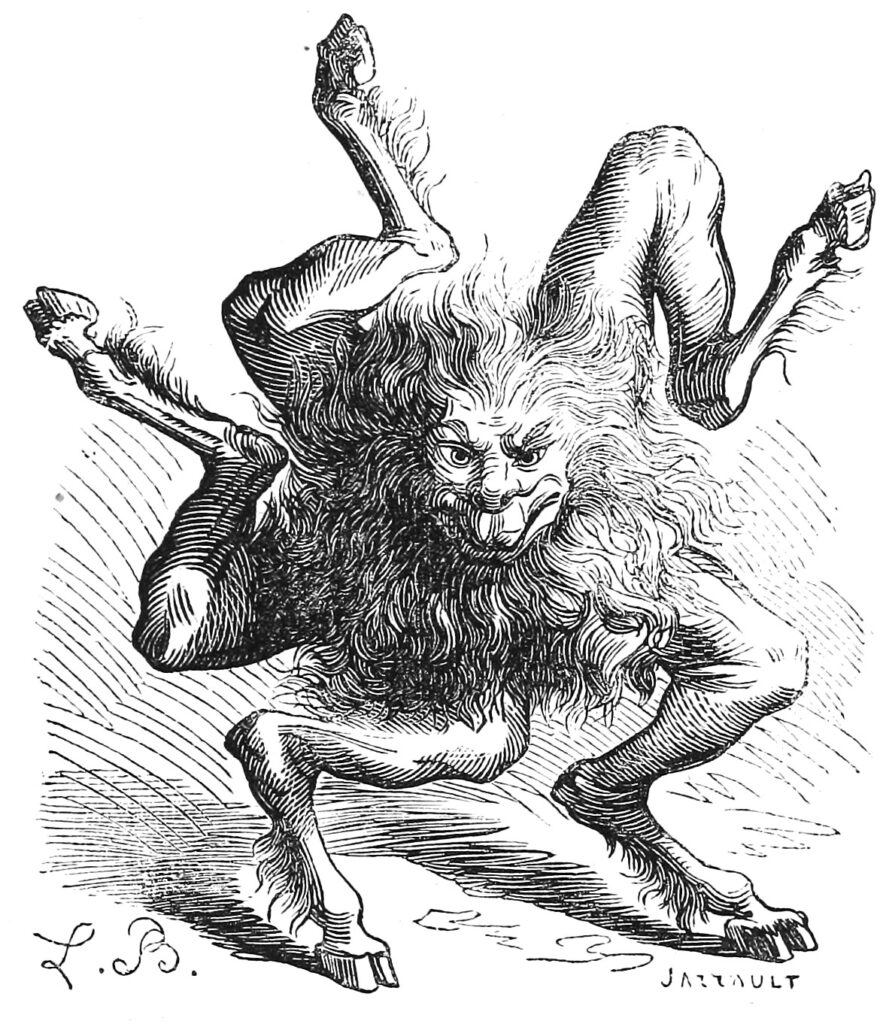


Podcast: Play in new window | Download

